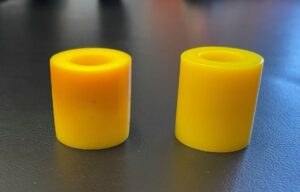Reducing Resistance to Allow Rocking
Michelle L. Lange, OTR/L, ATP/SMS
Meet Jozie
Jozie is a 3 1/2 year old girl with the diagnoses of epilepsy and West Syndrome. She received a manual tilt in space wheelchair with a Dynamic Back as she seeks out movement. Specifically, she likes to rock at her hips which decreases her agitation and increases her alertness level.
Changing Resistance Level
Jozie was seen after receiving the recommended equipment. The DRBi was installed with the default elastomers, which are Clear and provide a Medium level of resistance. She could barely compress these elastomers, which didn’t allow the rocking she seeks.
The elastomers were changed to a Soft (Yellow) level of resistance. She was able to more readily rock with these elastomers in place. Further compression of the elastomers created more energy absorption and helped her to return to a starting position. Sometimes clients who do not exert a great deal of force, yet who seek out movement through rocking, require a lower level of resistance so that the Dynamic Back responds more readily.
“Sometimes clients who do not exert a great deal of force, yet who seek out movement through rocking, require a lower level of resistance so that the Dynamic Back responds more readily.”
Elastomer Wear and Tear
Although Jozie does not move with a great deal of force, she does move a lot! As a result, she wore out the elastomers in about 8 months. The back was “sagging” into a more open seat to back angle and her parents noticed it was getting harder to lock-out the Dynamic Back. The elastomers needed to be replaced. Replacing the elastomers restored the correct seat to back angle, eased latching the Dynamic Back, and made the back more responsive to Jozie’s movements.
The Dynamic Rocker Back interface includes 4 different sets of elastomers, providing 4 different levels of resistance. It is critical to determine the optimal resistance level at equipment delivery so that the client has the best outcome using dynamic seating intervention. Clients who rock often require a lower level of resistance. Just as important is to regularly check the elastomers for wear. If the dynamic back is difficult to latch, the elastomers most likely need to be replaced.

